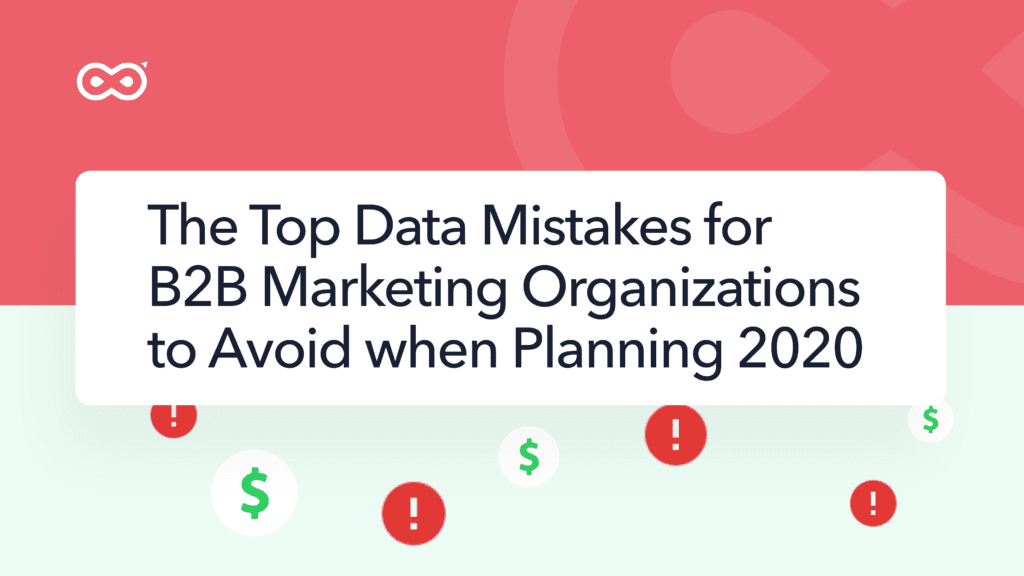When it comes to B2B marketing, there is no commodity more valuable than data.
Data has become one of the most important elements in the decision-making process of marketing leaders. Marketing leaders use their data to identify opportunities for growth, make decisions about where to invest their budget, optimize their results and drive performance.
But there can be problems with such a heavy reliance on your data…
Accuracy!
After all, we all know that garbage in, garbage out.
Inaccurate data can cause catastrophic problems for your marketing organization by creating uncertainty about whether you are really achieving your goals, the ROI of your marketing activities and if you are generating a positive impact on your business. Yikes!
To prevent data inaccuracy, data needs to be properly collected and analyzed to draw the correct insights and understandings. You need to make sure to avoid data mistakes to ensure accuracy.
With 2020 approaching, you’ll need to rely on accurate data in order to build a successful marketing plan and budget structure.
In this post, we will outline the top data mistakes that you need to avoid when collecting and analyzing your data.

Don’t ignore costs when calculating ROI
Yes, marketers, you know what we’re talking about!
With pressure to show ROI and prove the value of your marketing, you sometimes “neglect” to include certain costs in your ROI calculations. If there are any question marks about whether certain costs should be included in the calculation of marketing ROI, you prefer to exclude those costs.
Maybe its because you don’t want to show a lower ROI to management?
Maybe its because you legitimately believe that certain costs do not need to be included in the calculation of ROI?
To get the most accurate picture of your ROI, you should be including commonly excluded costs such as:
Freelancer and creative costs – That agency you have running your Facebook ad campaigns and the designer that you employ to design creatives add costs to your campaigns.
Tools – If you’re paying $2K per month for a tool to optimize Google Ads campaigns, you should include that cost when analyzing the ROI of that channel.
External expenses – Examples of external expenses can be travel costs and food at conferences that need to be factored into the cost of the event when calculating its ROI.
Headcount – Marketing is a team sport. You need to account for the salaries and benefits paid by the company to your marketing staff when calculating the true ROI of your marketing.
For example, when calculating the ROI of an event, make sure to include the costs of meals, hotels, air travel, taxis and swag in your calculations.
INCORRECT:
Sponsorship cost: $20,000 > Revenue Generated: $60,000
3X ROI
CORRECT:
Sponsorship cost: $20,000 + External costs: $10,000 > Revenue Generated: $60,000
2X ROI
By inaccurately calculating your ROI, especially at the channel level, you are painting the wrong picture of your results. You won’t know if your marketing activities are efficient and what impact they are having on the business. Even worse, if you make decisions because of these false calculations, you may be leading your marketing organization towards failure.
Sometimes, simplistic analysis is worse than no analysis at all.

Make sure your UTM tagging is flawless
UTM tracking is the primary method for marketers to track interactions of people and companies with their brand across marketing assets and activities (campaigns, ads, social posts, events, etc.), so later they can correlate that with business performance data.
In addition, using UTMs and centralizing your data is also going to provide you with a “source of truth” to eliminate data discrepancies between different ad platforms. Google’s goal is not to show you what’s really happening across channels, but to show you how everything happened because of Google 🙂
Despite it being a powerful tool for marketers to measure the top of the funnel effectiveness of their activities and a great way to keep your data organized, many marketing teams still mess up UTM tagging. This only makes measurement that much more difficult and wreaks havoc on the accuracy of your data.
There are 5 main UTM parameters that are most commonly used to accurately measure marketing activities.
- utm_campaign – this field should include the name of the specific campaign where the link originates (ie. CMO-interests)
- utm_ medium – this field needs to include the marketing medium where the link is being promoted (ie. cpc)
- utm_source – this fields needs to include the referrer where the campaign runs (ie. linkedin)
- utm_term – this field can be used to differentiate between keywords or
- utm_content – this field can be used to differentiate between ads or creatives
Let’s say you have a Google Ads campaign called “Acquisition” that is directing traffic to your home page (please don’t direct paid traffic to the homepage!!) and you have an ad called “we are better” for the keyword “competitor 1”. You’ll want to structure your destination link like this to make sure you are recording accurate data about the source of that traffic.
www.yourcompany.com?utm_source=google&utm_medium=cpc&utm_campaign=acquisition&utm_term=competitor1&utm_content=wearebetter
You’ll want to avoid some of the most common mistakes with UTM tagging to ensure you are organizing your data in a clear and concise way. Some common errors that I regularly come across are:
Misusing the UTM-Medium field: This is a very important parameter. It determines what “bucket” you data will be filed into. There should only be a limited number of utm_mediums that you use (primarily cpc, referral, social, email, partners, etc.).
Using multiple campaign names for the same campaign: Pretty simple but often done. Create a single name for a campaign and stick with it when UTM tagging across your different mediums. Failure to do so will make tracking the success of your campaigns very difficult and highly inaccurate.
UTM tagging internal links on your website: If you want to find out how many people got to a specific page from a specific element, use a ref= tag and not a UTM tag. Using a UTM tag for internal site links will override the original source data.
Not being able to understand which activities and campaigns are driving traffic and generating results will make the analysis of your data much more difficult. Poor, inconsistent UTM tagging will simply pollute your data. To prevent this from happening, employ disciplined UTM tagging so everything is clear when it comes time to analyze your data.

Properly Structure Your Budget
The way in which you structure and plan your budget plays a significant role in how you collect, categorize and analyze your data. Well-defined budget structures enable you to perform more accurate analysis and provides greater visibility into the impact of your marketing categories and channels.
Unfortunately, many marketing organizations do a poor job of structuring their budgets. They often build overly complex hierarchies that mix up channels, categories and goals, which creates chaos when it comes time to analyze your data. Sound familiar?
When building your budget hierarchy for 2020, avoid the following errors:
Treat Goals as Categories
Never classify something that should be a goal as a category. Marketing channels, like LinkedIn ads, can be used to achieve multiple goals like lead generation, brand awareness and increasing website traffic so it doesn’t make sense to list it as under a goal. Make sure your categories are correct and list the correct marketing channels under it.
INCORRECT:
- Lead Generation
- LinkedIn Ads
- Twitter Ads
- Facebook Ads
- Quora Ads
CORRECT:
- Paid Social
- LinkedIn Ads
- Twitter Ads
- Facebook Ads
- Quora Ads
Overcomplicating the structure
Very often, companies list too many marketing channels when in reality, they are just different campaign types. This ends up complicating how you classify your data. An example would be listing every event type as a channel under your “Events” category. Let’s face it, they are really just different campaigns and can be categorized under just a few channels.
INCORRECT:
- Events
- Event 1 type
- Event 2 type
- Event 3 type
- Event 4 type
- Event 5 type
CORRECT:
- Events
- Speaking Engagements
- Sponsorships
- Meetups
Defining channel categories as channels
This is a bad one. Listing a channel category, like Social, as a channel will not only cause issues when collecting and classifying your data, but it will cause you to compare different dimensions. How can you compare the performance of Social to Google Ads? You are comparing apples to oranges since once is a category and the other is a channel. When collecting and analyzing your data, make sure you have set the correct top-level categories with the respective marketing channels listed beneath.
INCORRECT:
Comparing
- Social
- Social
to
- Paid Search
- Google Ads
- Bing Ads
CORRECT:
Comparing
- Social
- YouTube
to
- Paid Search
- Google Ads
- Bing Ads
Structuring based on finance/ERP terminology
OK, we know we’re always telling you to build a close relationship with Finance. That doesn’t mean that you should be joining their team! When structuring your marketing budget, it will definitely please finance if you use their ERP terminology and structure, but at the end of the day, it’s your marketing budget. Use the terminology that makes the most sense to you. Map out your structure with the corresponding finance terms/keys for later reporting to make sure everyone is aligned (and your relationship with finance remains loving).
Before building your 2020 marketing plan, do yourself a favour…make sure to avoid making these top data mistakes. By avoiding these mistakes, you will set yourself up to build a successful marketing plan for 2020 that will drive success for your marketing organization and the business.



